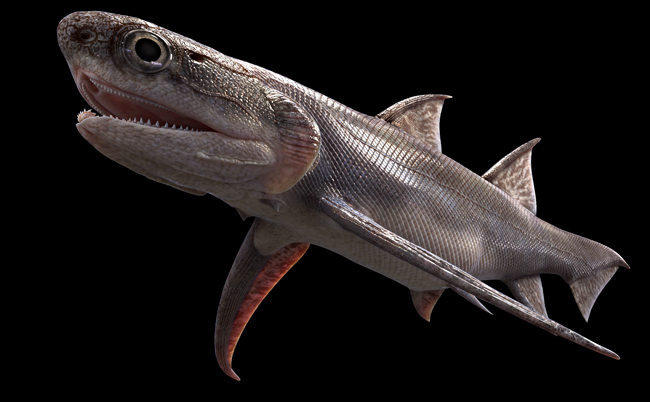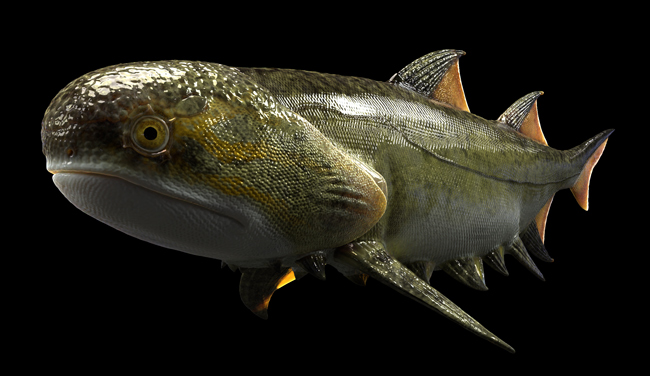Research Suggests Ancient “Sharks” Appeared Much Earlier
Newly published research suggests that ancient “sharks” appeared much earlier than previously thought. A fossil from China represents a new species of jawed fish (Qianodus duplicis) and its discovery suggests that fishes with true jaws first evolved in the Early Silurian.

An Early Silurian Origin of Shark-like Jaws
The scientific paper, published in the journal “Nature” identifies Q. duplicis as the earliest record of a toothed gnathostome known to science. Its discovery extends the record of toothed gnathostomes by some 14 million years from the Late Silurian into the Early Silurian (around 439 million years ago).
The fossils (a handful of tiny teeth), found in China represent the earliest direct evidence for jawed vertebrates known to science.
Previously, the earliest jawed fish to be positively identified, included species from the Late Silurian, fossils thought to date from around 424 million years ago. These include the placoderms (Class Placodermi) partially armoured gnathostomes, and sarcopterygians, bony “lobe-finned” fishes found initially in China and Vietnam.
Confirming Evidence from Fossil Fish Scales
Co-author of the paper, Dr Ivan Sansom (University of Birmingham), commented:
“Until this point, we’ve picked up hints from fossil scales that the evolution of jawed fish occurred much earlier in the fossil record, but have not uncovered anything definite in the form of fossil teeth or fin spines.”
Construction workers building a new road in Guizhou Province uncovered fossil material and field teams from the Chinese Institute of Vertebrate Palaeontology and Palaeoanthropology (IVPP) and the Qujing Normal University (QJNU), were despatched to take samples and to analyse the Silurian-aged deposits.
The scientists found numerous scales, but also recovered several miniscule fossil teeth between 1.5 mm and 2.5 mm in length.
Dr Sansom explained:
“Scales are relatively easy to find because they are so plentiful, but teeth are much scarcer. The scale and speed at which IVPP and QJNU colleagues were able to sift through the material enabled us to identify these scarce remains more effectively than in previous projects.”
Around twenty of the tiny fossil teeth turned out to be from the same species (Qianodus duplicis). From the arrangement of the teeth and their morphology, the team established that they would have come from a fish with an arched jaw margin, with offset tooth rows, similar to those found in extant sharks. The team used a range of techniques, including Computed Tomography (CT scans), to establish a date for the samples.
What’s in a Name?
The new species Qianodus duplicis comes from “Qian” the ancient name for Guizhou Province, “odus” from the Greek for tooth, and duplicis, or double, referring to the paired rows of teeth.
A Cartilaginous Fish – Fanjingshania renovata
In a separate paper, also published today in Nature, the team also identified fossil elements that relate to “fin spines”, bony projections in front of the fins which can be seen today on Port Jackson sharks. These spiny structures form the basis for the identification of a new species Fanjingshania renovata named after Mount Fanjingshan which is close to the locality from where the fossil material was collected. The species name “renovata”, acknowledges renewal, the remodelling of the base of the spines and scales.
Lead author of both papers Dr Plamen Andreev (Qujing Normal University), commented:
“The early so-called “spiny sharks” had these features on all of their fins, but the examples that we have found belong to a much earlier period. These are the first creatures that we would recognise today as fish-like, evolving from creatures often referred to as “clams with tails”, from earlier in the Ordovician period.”
Ancient “Sharks” Appeared Much Earlier
Cartilaginous fish (chondrichthyans), including sharks, separated off at some point from osteichthyans (bony fish and tetrapods), from which our own species eventually evolved. The point at which this occurred, however, is obscured within ghost lineages in the Ordovician, where only hints in the fossil record have been found. Precisely how and when this separation happened, therefore, remains ambiguous.

Everything Dinosaur acknowledges the assistance of a media release from the University of Birmingham in the compilation of this article.
The scientific paper: “The oldest gnathostome teeth” by Plamen S. Andreev, Ivan J. Sansom, Qiang Li, Wenjin Zhao, Jianhua Wang, Chun-Chieh Wang, Lijian Peng, Liantao Jia, Tuo Qiao and Min Zhu published in Nature.
The scientific paper announcing Fanjingshania renovata: “Spiny chondrichthyan from the lower Silurian of South China” by Plamen S. Andreev, Ivan J. Sansom, Qiang Li, Wenjin Zhao, Jianhua Wang, Chun-Chieh Wang, Lijian Peng, Liantao Jia, Tuo Qiao and Min Zhu published in Nature.


